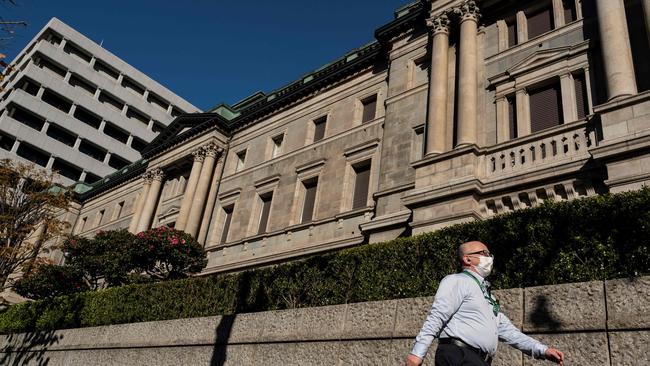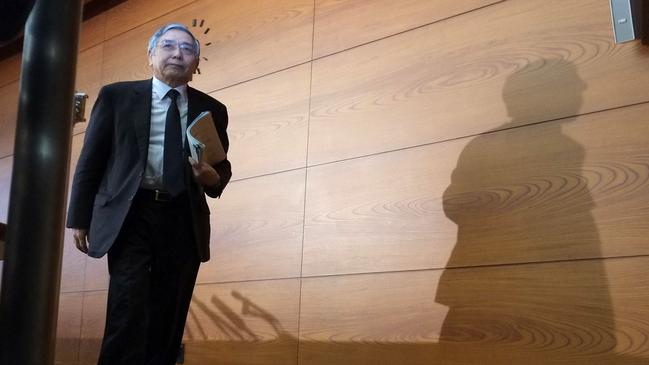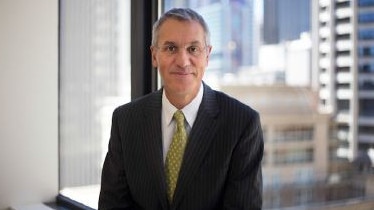Bank of Japan insists shift on 10-year bonds isn’t a rate hike or an exit from the yield policy
BoJ governor Haruhiko Kuroda has been adamant the expansion of the yield curve target range wasn’t under consideration. Clearly there’s been a change of strategy.

US inflation and the Federal Reserve’s response hold the biggest clues to market returns in 2023.
But the European Central Bank’s increasingly aggressive stance on rates is also drawing attention, and this week the Bank of Japan set the cat among the pigeons when it watered down its bond yield curve control.
It comes as bad news on the US and European economies starts to be viewed as bad for shares, not least because the Fed and ECB remain resolutely hawkish.
Their outlooks suggest a “pivot” to rate cuts is some way off, despite recession risks.
Combined with the negative impact on the global bond market of the BoJ’s effective “de-anchoring” of the 10-year Japanese government bond yield from zero on Tuesday, Australia’s sharemarket dived to a seven-week low. But it ended a four-day losing streak on Wednesday after a similar move in the US.
Despite the midweek rebound, it hasn’t exactly been a joyful run into Christmas. After a weak first two weeks of December, the US and Australian markets were slightly down at the start of what’s normally a solid final two weeks.

Interestingly, BoJ governor Haruhiko Kuroda insisted that the decision to widen its allowable trading range on the 10-year JGB from 25 to 50 basis points wasn’t a rate hike or an exit from the yield curve control policy. Perhaps so, but it’s the beginning of the end.
Certainly it was nothing like the stunning capitulation by Australia’s own Reserve Bank in November 2021, when it abandoned its three-year bond yield target in response to sustained pressure from the market, as well as a pick-up in the domestic economy.
“Governor Kuroda has been telling anyone who would listen in recent months (that expansion of the yield curve target range) wasn’t under consideration, since it would, he said, be tantamount to a rate rise,” said NAB’s head of FX strategy, Ray Attrill. “Last night he told us the move is not a rate hike.” The BoJ took his award for “the most unpredictable central bank of 2022”.
While justifying the move in terms of more effective market functioning and the distortion in the yield curve at the 10-year target point – and distorted it was – alongside claiming it was not a monetary policy change, the shock BoJ announcement gave succour to recent media reports suggesting the government was contemplating a tweak to the BoJ’s remit.

The reports said that would allow for greater flexibility in relation to achieving its 2 per cent inflation target. Ostensibly it would lower the bar for a move off the negative policy rate and zero per cent, 10-year bond yield target at some stage next year.
It now sets the scene for the BoJ to join the cadre of central banks raising rates in 2023.
NAB’s view remains that any formal policy changes in this regard are contingent on next spring’s Shunto (large firms) and Rengo (more SME-focused) wage negotiations and the need to see outcomes deemed consistent with the 2 per cent inflation target.
“Only then, and post the appointment of Kuroda’s successor, might we see a policy change,” Mr Attrill said.
“That said, this tweak has – whatever the BoJ will have us believe – been interpreted as putting the writing on the wall for a policy shift next year almost regardless of the 2023 wage round.
“It is also seen as signifying a formal end to tolerance/desirability of yen weakness.”
While it did weigh on the US dollar index – and a falling greenback tends to improve with an improving risk appetite globally – the yen is, like the greenback, another safe-haven currency.
Thus, the risk-sensitive Aussie dollar dipped to a four-week low against the greenback and closed Tuesday down more than 4 per cent against the yen.
Meanwhile, Citi said that despite last week’s softer-than-expected November US CPI, which mechanically lowered its inflation forecasts for year-end 2022, “if anything we are more convinced over the last week that relatively softer core inflation prints will not last into 2023”.
Legislation in US Congress this week is likely to delay payment cuts from Medicare to health service providers, leading Citi to remove an expected one-off drop in medical services prices in January, said the investment bank’s chief economist, Andrew Hollenhorst.
Additionally, data through the first half of December for the index of wholesale used car prices showed a 1.6 per cent increase, implying a renewed climb in the used cars component of CPI.
“While core CPI could appear soft again in December data, we expect to see at least a few months of 0.4-0.5 per cent month-on-month core CPI prints again in early 2023,” Mr Hollenhorst said.
“While our inflation forecasts were revised lower for 2022 after the release of November CPI data, we actually revised our 2023 inflation forecasts notably higher, particularly for core PCE inflation which we now expect to end next year at 4.3 per cent year-on-year, up from 4 per cent previously.”
But Citi’s equity strategists say the key is how much drawdown risk there is from here, assuming recession conditions during 2023, given that it “may be the most anticipated recession in a generation” and “investors need to allow that historic recession playbooks may disappoint”.
“We argue that this year’s sell-off into the June and October lows mostly priced in recession risk, as valuations compressed in response to Fed actions and interest rate response,” said Citi’s chief US equity strategist Scott Chronert. He has a 4000 year-end target for the S&P 500.




To join the conversation, please log in. Don't have an account? Register
Join the conversation, you are commenting as Logout